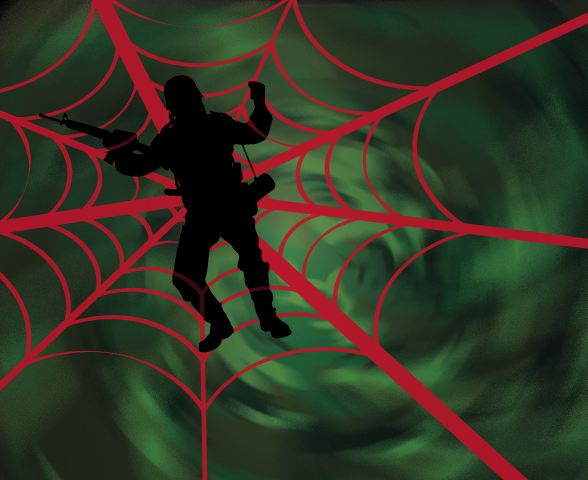The content in this article is an extract of Spotlight Brief 4/21.
The landscape of Hybrid Threats: A conceptual model
The European Centre of Excellence for Countering Hybrid Threats – Feb 21
This product comes out of an assessment that hybrid threats are much older than most recent security discussion suggests and that our methods of addressing them are outdated. The authors argue that there has been little progress analysing and addressing hybrid threats due to their complexity and a lack of common understanding. With this work, the Joint Research Centre of the European Commission and the European Centre of Excellence for Countering Hybrid Threats have joined forces to develop a conceptual model and framework for characterising hybrid threats. The model breaks the threat down into four pillars: actors, domains, tools and phases. This allows for the creation of multi-Department, multi-phased, complex responses with multiple lines of effort (an expected outcome when dealing with hybrid threats) and the early identification of emerging hybrid activities or threats.
Related:
‘Responding to ‘grey zone’ attacks’, Australian Naval Institute, 15 May 21
‘Tackling Hybrid Warfare: The Salisbury Poisoning Three Years On’, Ripjar, 08 Mar 21
‘Whispers from Wargames about the Gray Zone’, War on the Rocks, 08 Mar 21
‘What is “Hybrid Warfare,” Really?’, Center for European Policy Analysis, 24 Feb 21
‘Energy security in the era of hybrid warfare’, NATO Review, 13 Jan 21
Water and Warfare: The Evolution and Operation of the Water Taboo
International Security – Apr 21
The securitisation of water access has been a major policy concern for decades. Increasingly explicit guidance on water securitisation has featured in international policy making from the 1970s onwards; coercion around water is now a ‘taboo’. Charlotte Grech-Madin traces this taboo history and finds that the growth in this taboo has influenced States at various levels, internally and externally.
Related:
‘Egypt Asks for UN Help in Long-Running Ethiopian Dam Dispute’, Bloomberg, 13 Jun 21
‘Finding a new approach to water security in Southeast Asia’, The Interpreter, 04 Jun 21
‘What Is a Water War?’, The Diplomat, 24 Mar 21
‘US Water Plant Suffers Cyber Attack Through the Front Door’, RUSI, 10 Feb 21
‘Syria: Are water supplies being weaponized by Turkey?’, Deutsche Welle, 24 Jan 21
Force structure and counterinsurgency outcome: the case of the Cyprus Emergency (1955-1959)
Defence Studies – Feb 21
A common strategic refrain from the Cold War is that mechanised forces are less likely to conduct successful counterinsurgency wars. This idea was popularised in 2009 by Jason Lyall and Isaiah Wilson’s work Rise against the Machines: Explaining Outcomes in Counterinsurgency Wars. This idea coupled with the rise of COIN conflicts has led to the downsizing mechanised forces in the post-Cold War era despite the limitations this poses on a military’s capability to fight a peer war. Experience in Afghanistan and Iraq have called into question this ‘gospel’, especially the surge success in 2007. In this article, Fausto Scarinzi examines a dismounted infantry and police focused force that failed to achieve success in Cyprus, despite an ‘optimal’ force construct. This historical case study undermines one the greater perceived obstacles to mechanising an Army, reinforcing the growing weight of scholarship that shows mechanised forces can conduct COIN.
Related:
‘Cyprus’, National Army Museum, 2017
‘The Principles of Destruction in Irregular Warfare: Theory and Practice’, Small Wars Journal, 01 Apr 12
‘Mechanized Forces in Irregular Warfare’, Military Review, Mar – Apr 11
‘Death Before Dismount?: Mechanization, Force Employment, and Counterinsurgency Outcomes in Iraq’, Massachusetts Institute of Technology Political Science thesis, Feb 11
‘Rage against the Machines: Explaining Outcomes in Counterinsurgency Wars’, International Organization, Winter 09
Remote Warfare: A Critical Introduction
E-International Relations – Feb 21
For the majority of this century, major powers have pursued warfare remotely. This article attests that instead of deploying significant forces, belligerents have chosen to rely on training and supporting local paramilitary groups, providing them with high-end technical support. In theory, this poses less costs and risk to the intervening nation. This form of warfare has been prevalent across the Middle East and Northern Africa. It is not just the preferred Western approach – states like Russia and Iran have also adopted it. In this introduction to Remote Warfare: Interdisciplinary Perspectives, Abigail Watson and Alasdair McKay link recent and historical examples to explain this phenomenon and the changing character of war. Critically, they also point out significant flaws with remote warfare, notably the difficulty protecting civilians, its long-term impact on stability, and the lack of transparency and accountability.
Related:
‘Remote warfare will not end age-old Israel-Palestine conflict’, Business Day, 20 May 21
‘American Special Ops Forces are Everywhere’, The Atlantic, 12 Mar 21
Remote Warfare: Interdisciplinary Perspectives, E-International Relations, 2021
‘Military drones are changing, as are the wars they're fighting. Here's what's happening now’, ABC News, 26 Feb 21
‘To End the Forever Wars, Rein in the Drones’, Just Security, 16 Feb 21



